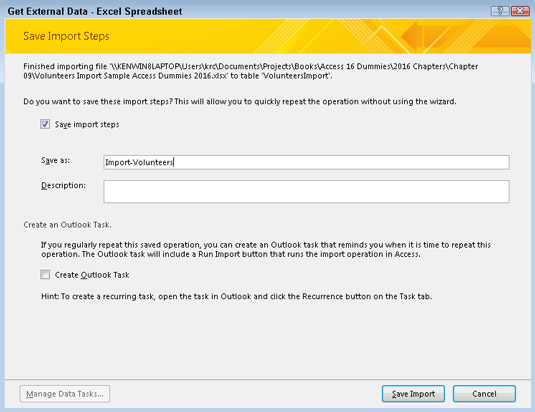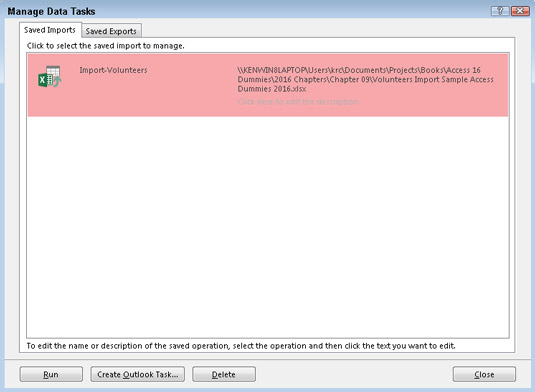If you want the database in which you’re placing the data to replace the source in Access 2016, then import. This is the option for you if you’re creating an Access database to replace an old spreadsheet that no longer meets your needs. Also import if the source data is supplied by an outside vendor in a format other than an Access format.
For example, suppose you receive cash-register sales data from an outside vendor on a monthly basis in spreadsheet format. Access is a great tool for reporting, so you can import the data into Access and use its reporting tools to generate your reports.
Here are the steps for importing or linking data sources to your Access database:
Open the Access database that will hold the imported data.
You should see the External Data tab.
Click the External Data tab on the Ribbon.

The Import & Link group of buttons appears on the Ribbon.
Each button is connected to a wizard that walks you through the process:
Common file formats such as Excel or Text (labeled as Text File) have their own specific buttons.
You can find the less common file formats using the More button.
Click the button that matches your file format.

A Get External Data dialog box specific to the selected file format appears onscreen.
Use the Browse button to select the data source that you want to import or link to Access.
Usually this is a file. It could also be a SharePoint site or an Outlook folder.
If typing filenames is not your thing, click the Browse button to locate the file.
Select the method of data storage.
This is where you tell Access whether to import or link the data. You can link to all file formats except XML.
Follow the remaining steps in the Get External Data dialog box.

From this point forward, the steps depend on which data format you’re importing. Follow the prompts carefully. The worst that can happen is that you get an imported (or linked) table full of gibberish. If you do, check the format of the source file.
For example, if the source is a text file and you get gibberish, you may need to confirm that the text file was saved as a delimited file (with a character — a comma, for example — placed between fields). It’s also possible that the source file isn’t in the correct format (for example, you may think it’s an Excel spreadsheet but it’s not).
If you expect to import or link to this type of file often, click the Save Import Steps check box. (The check box will be located on the last screen of the wizard.) After you check the box, you’ll be prompted for a name for your import.
The External Data tab’s Import group on the Ribbon contains a button called Saved Imports. You can use this button to call up saved imports and run them as often as you like.

Data sources must remain in their original locations with their original names to rerun a saved import.





